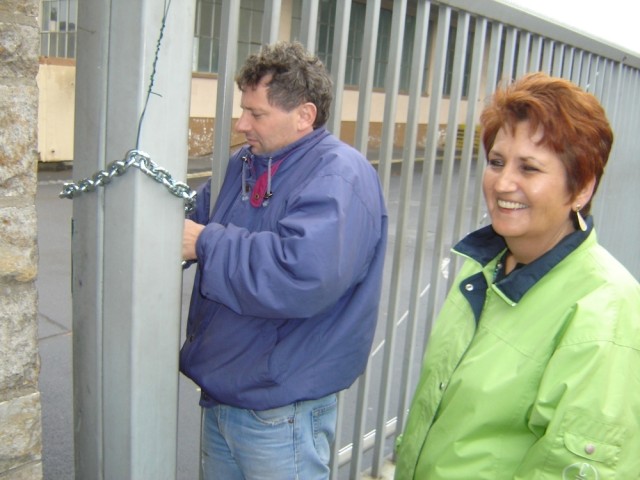
WUERZBURG, Germany (Army News Service, Oct. 23, 2007) - Wuerzburg's Faulenberg Kaserne, a military installation since 1877 and home to U.S. Soldiers since 1947, has been returned to the German government.
In its early days, the kaserne was a German army headquarters and stable. When the Americans moved in after World War II, Faulenberg Kaserne became home to U.S. Army, Europe's quartermaster laundry service and to a number of regional command headquarters, including the 98th Area Support Group, the Army's Regional Contracting Office, the Army's Criminal Intelligence Command, and the Army and Air Force Exchange Service.
Returning the kaserne to German authorities was bittersweet for many of the Army agents responsible for doing so.
Maria Assaad worked on Faulenberg for 31 years. Now, as chief of real estate operations with U.S. Army Garrison Schweinfurt's Directorate of Public Works, she was responsible for all facets of the closure - and delivered the kaserne's keys to its new German owners Sept. 27.
She will oversee the return of all other area installations, including the Wuerzburg Army hospital later this year and Leighton Barracks next year.
"It's stressful," Ms. Assaad said, summarizing efforts to close and return the installation. "It's like stepping into another life. We have a saying in German that when something falls, it's a chance to make a new beginning. That's what's happening here."
Ms. Assaad assisted Johann Neumann from the German Bundesanstalt fur Immobidienaufgaben, the German official estate property office, as he chained the front gate. Two DPW trucks and a forklift were the last Army vehicles to exit the kaserne.
"Wuerzburg has always been a friendly host town, a very friendly city," said Fred Rashnavadi, master planner for USAG Schweinfurt DPW, echoing sentiments expressed by many Americans during recent installation closures.
Rashnavadi, from Fort Lauderdale, Fla., has lived in the Wuerzburg area since 1994. A former Army aviator, he was stationed at nearby Giebelstadt Airfield before retiring from active duty and taking on his new role.
Mr. Rashnavadi is responsible for planning and coordinating details for all installation closures, including those at Kitzingen's Harvey and Larson Barracks, and Giebelstadt Airfield in the past year.
"The whole place has to be empty. We had to find remaining tenants new homes, then all the furniture and property book items are turned in after being cross-leveled with other installations that may want it," he said, outlining only a few requirements of shutting down an installation.
"The buildings have to be empty and broom swept," added Reiner Loeffler, from the Army's Installation Management Office in Munich.
There was optimism that the kaserne might serve a useful purpose in the coming years.
"In my opinion, in Wuerzburg they can do something with the real estate. It's not like in other communities where (the installations are) just collecting dust because the infrastructure is not in place to develop them," observed James Crider, a veteran of 26 years with USAG Schweinfurt's DPW.
The day was perhaps most bittersweet for Peter Bonnet, the former DPW chief of utilities at Faulenberg. Employed by the U.S. Army since 1973, Bonnet was keen to point out many innovations and maintenance projects that had taken place on the kaserne.
"When I started in 1973, we had 150 boiler firemen who shoveled coal into furnaces on Hindenberg Kaserne and Emory and Leighton Barracks. Faulenberg used heating oil, except for Building 220," he said.
"We did a sewer study a number of years ago and found there are seven inlets to the city's sewer system. Most of the sewers are like those you'd find in London," he added.
He recalled the construction on installation's transformer stations 29 years ago in order to accommodate American 110-volt requirements.
Mr. Bonnet was most proud of the high-pressure steam plant near the kaserne's main entrance, saying the plant can produce 15 tons of steam per hour to warm the installation and also power the quartermaster laundry facility. He noted the soft-water production element, vital to the laundry service, was built the same time as the steam plant.
"Americans have always been fair employers; it was nice working here," Mr. Bonnet said. "And there's still much to do."
Mr. Rashnavadi recalled directing a project to refit all the plumbing in the laundry facility.
"The plumbing was pre-World War II, made of lead, and leaking everywhere. The project called for putting in all new steam lines, at a cost of $130,000. When it was finished, the project cut the installation's energy bill by more than half. The project paid for itself in three months," Mr. Rashnavadi said.
Representing American interests at the facility turnover were mostly German employees working for the U.S. Army. They passed the keys to a group of local BIMA officials, including: Hans Tranitz, chief of Wuerzburg's BIMA office; Soren Wolk and Roland Albert, facility managers; Petra Bauer, property sales; and Gregor Neeb, real estate inspector. Mr. Neeb once worked as a steam fitter at Faulenberg before taking a position with the German government.
Norbert Gallena, representing the Wuerzburg Staatliches Bauamt, fielded two teams of five specialized inspectors who examined not only the heat, water, and electric utilities, but also the streets, water drainage and landscape. His office cleared the installation for return to the Germans.
(Roger Teel serves with USAG Schweinfurt Public Affairs)

Social Sharing